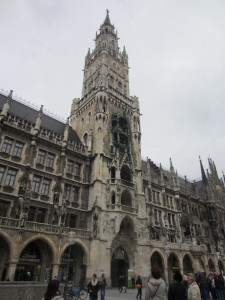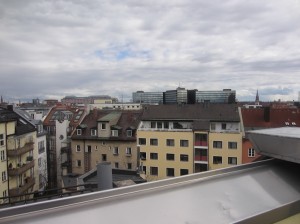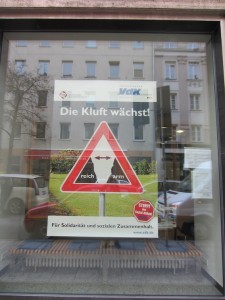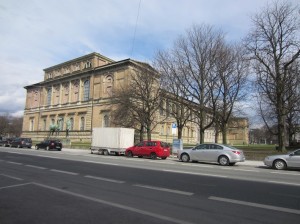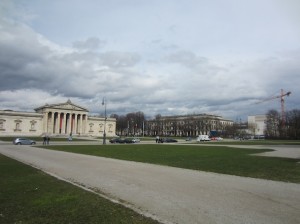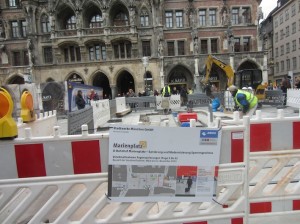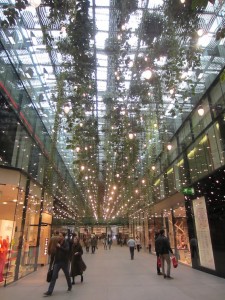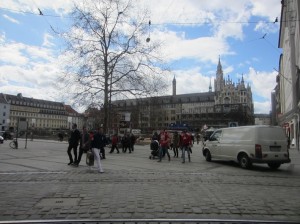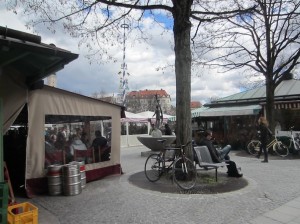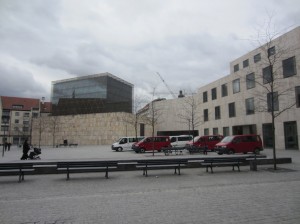OC 57: Munich observed afresh
Imperial traces
No matter how long ago and for how long a city has been a seat of domination, no matter how often its power has waxed and waned, a presence of its historic glory remains unmistaken. Munich is one such historic seat of power, wealth and might. The biased eyes of an urbanist will spot signs and moments of past grandeur, but they will also detect vestiges of decline and utter destruction.
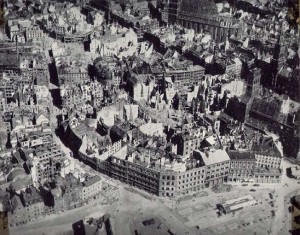
2_dia Marienplatz and city centre immediately after the second world war, source: http://www.ericringsby.com/getz/3rdusarmygal3.htm
Money, knowledge and spirituality – a basis for a social market
Power it could be argued may have moved to Berlin, but Munich has shed its marginal position and is once again a powerhouse in central Europe. With a population of 1.35 million (conurbation 2.6 m, Munich Metropolitan region 5.5 m) it is the third city of Germany after Berlin (3.46 m) and Hamburg (1.78 m). The city seems to be booming at present, but it has an inflated number of people in working age which will bring about issues of an ageing population. The city lives of its financial sector (second after Frankfurt but first regarding insurance), the media and publishing. It has strong universities and cultural activities, is the seat of the scientific Max Planck institute, hosts BMW with its research centre and has just built Germany’s second international hub airport.
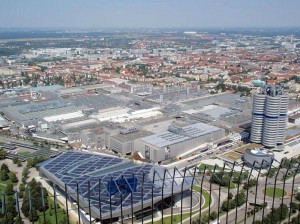
3_dia BMW plant and headquarters, source: http://www.businessinsider.com/best-corporate-buildings-in-the-world-2013-4?op=1
Munich preserves its long standing spiritual heritage, reflected in its social market economy. The many churches and tall church spires reaching above the compact medium rise city are material witnesses. Only the European patent office reaches above the built up horizon, together with a single tower block which used to be some corporate head quarter and is now being transformed into luxury flats. So no worldly spires to mammon on the skyline, and no minarets either.
Despite its history as a catholic bastion, almost half of Munich’s population has no religious affiliation. The city has been ruled most of the time since the second world war by the social democrats (SPD). The SPD is currently in coalition with the greens and the pink list. This may explain why the largest single sex bathhouse of Europe is located in the heart of Munich. Munich has a reputation of liveability and innovation and attracts immigrants, mainly from wider Europe. Munich is the capital of the Christian Social Union (CSU, the Bavarian brand of right wing politics) dominated Free State of Bavaria and hosts all the state institutions.
Compact and green-blue city morphology
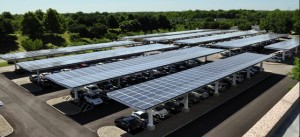
5_dia Munich Re is heavily involve in implementation of large scale photovoltaic plant, source: http://solarsofa.com/first-performance-warranty-insurance-provided-in-the-u-s-for-photovoltaic-panels/
Munich has a track record of pioneering green policies which date way back to the early environmentalist waves. The city doubles that up with energy efficiency, recycling and sustainable development strategies.
As a green-blue city with many large parks and river walks along the Isar Munich offers quality of life which is also reflected in it being the most expensive city of Germany. Although polarisation does not seem as extreme as elsewhere, not least in London, there are signs that not everyone has access to the comfort zone.
Its planning is far from adventurous though. Gravely damaged by the second world war, it rebuilt itself on existing street patterns. Rather dull grey medium height buildings are still lining the streets and only the rebuilt churches and monuments and their spires are reaching above the urban blocks. Reconstruction was swift and had been building on continuous feedback from the population till this day.
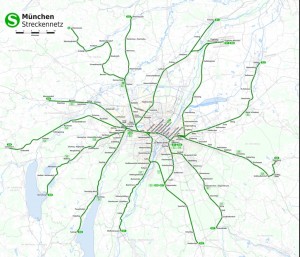
7_Concentric- radial Munich plan, source: www.muenchen.de/rathaus/Stadtverwaltung/Referat-fuer-Stadtplanung-und-Bauordnung/Stadtentwicklung/stadt-bau-plan/city-building-plan/cbp_phase_7.html
The 1963 concentric plan with radials round the clock was based on the ‘preserving renewal’ principle.
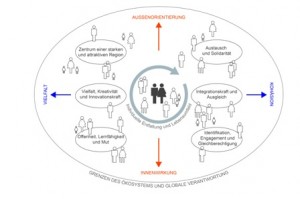
8_dia diagram: Munich planning principles today, source: http://muenchen-mitdenken.de/inhalt/leitmotiv-der-stadtentwicklung
A successful example is the Old Pinakotek, one of Munich’s major museums. Only the main structural features were rebuilt between the surviving vestiges, thus reinstating the overall mass of the building but omitting its historic decorations. The New Pinakotek was added as a contemporary building but in similar bulk and stature. The same was repeated later on with the third exhibition space currently under refurbishment. The spaces between remain monumental and a little bleak, despite the sculptures and trees which enliven them.
Planning evolved into a more polycentric structure in 1975 with selected higher density centres on the edge of the ‘bacon belt’, meaning a very rural hinterland. At the end of the cold war, military bases were abandoned which freed a lot of urban land for redevelopment, including for a new enhanced exhibition and convention centre. No new plan was proposed in 1998. Instead the ‘Munich perspective’ was adopted, a flexible framework with guidelines to cope with globalisation, supporting the principles of compact city, mixed development, and green corridors.
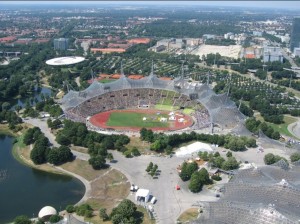
11_dia Olympic park today, source: http://www.planetware.com/munich/munich-olympic-park-d-ba-munols.htm
Munich today
What is the impression of urban living in Munich today? The city is punctuated with cranes, the roads are being dug up throughout the centre and cars are everywhere. The city resembles a gigantic building site rather than a place of harmonious living, working and playing. It seems as if the heart of the city was being pedestrianised. Indeed, many passages have been opened which run through the large city blocks and link up with each other across wide boulevards, partly freed from traffic.
The jury is still out on how to share streets between public transport, cars, cycles and pedestrians. Paving the streets across their whole width without elevated pavements may create a false sense of safety though, notwithstanding the ‘official’ vehicles – police and local authority vans – mingling among dense pedestrian flows, besides delivery vehicles and motorcycles.
Some inner city parts have been completely redesigned. The maze of gallerias linking up with existing shopping streets is one example, the Jewish cultural quarter another. The statistics show that the proportion of Jewish population is small among people living in Munich. However, the city decided to create a quarter with a new synagogue, a Jewish museum, a Jewish community centre with restaurants, children play areas and educational facilities, right in the old heart of the city, near the main market and opposite the City museum. There too, unfortunately the paved area is being invaded by vans waiting to transport children and obstructing the view onto the synagogue from the sitting area.
Cars are also traversing the open spaces between the various museums containing antiquities. Similarly, the area between them and the modern art museum is sliced by a boulevard with busy traffic. Munich could take a leaf out of Salvatore Rueda’s work on creating a traffic hierarchy across the Cerda grid in Barcelona, concentrating traffic flows on fewer main drags and freeing the other streets for greater quality of life.
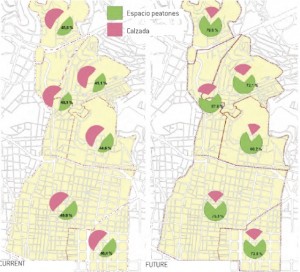
17_dia Salvador Rueda project, source: Fundacion Metropoli (Judith Ryser, Building the European Diagonal, 2008)

